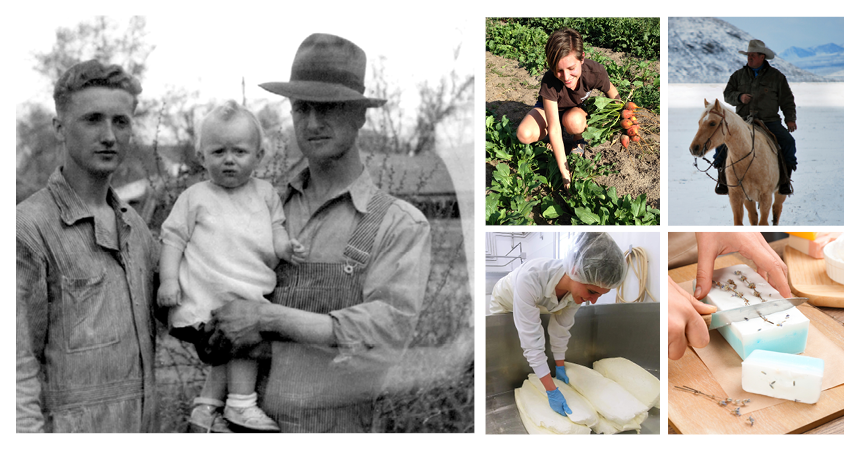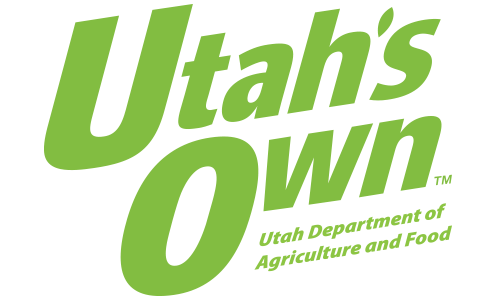
Utah Family Farms: Reimagined
If you could talk to the early settlers of Utah, perhaps they might share their wisdom of adaptation. With a bit of planning, tenacity, and a whole lot of hard work, those early settlers set up communities unlike any established before. Instead of deeding large parcels of land to individual farms, Utah pioneers created a community grid system to live near one another and then farmed the fertile land on the outskirts of town. They diverted water from mountain streams and established a canal system to support a self-sustaining food system. Life wasn’t easy with Mormon crickets destroying crops, early and late frosts, and noshing on Sego Lilies to supplement poor harvests. However, in the end, their infrastructure thrived and grew in success as more than 400 settlements were established across the state.
By 1896, the average size of a family farm was about 50 acres – (think about 50 football fields placed side-by-side for a modern-day reference). The most common crops were oats, barley, and wheat, alongside alfalfa and grass hay for livestock. There was also a strong garden community with most, if not all, families growing their own food for sustenance. Several of those early pioneers set up homesteads in one area only to be reassigned to another community a few years later.
By comparison, adaptation has definitely been synonymous with Utah agriculture today. Consider Johnson Family Farms, a local produce grower and century farm in Benson, Utah. The farm began as a commodity farm, with first-generation “Great-Grandpa Johnson” growing large amounts of alfalfa and wheat. Like most early Utahns, he also established a tradition of planting a large garden to provide the family with fresh produce to eat and preserve. The love for gardening was passed from generation to generation, until fourth generation brothers, Kelby and Braydon Johnson, decided it was time for the garden to become the farm.
Kelby and Braydon, with true pioneer grit, convinced their dad to let them expand the family garden plot to 1/10th of an acre to grow additional vegetables to sell at the local farmers market. Braydon & Kelby applied the agronomy practices learned from their Utah State University classes and soon had a thriving CSA and regular customers at the Cache Valley Gardeners Market. A few years later, they built their first greenhouse to capitalize on seasonal extension and convinced their dad to give them a few more acres.

Kelby often says, with a satisfactory twinkle in his eye, “Our dad was amazed how we could make a farm profit from our small acreage. It took a lot of persuasion, but soon we convinced him the risk of switching to produce was worth the reward. It was the only way Braydon and I could make a living on the farm.”
Since that shift more than 10 years ago, the fourth generation continues to adapt to a changing market by diversifying crop production and experimenting with season extension. While you’ll still find them selling produce weekly at the Cache Valley Gardeners Market, they have also established retail accounts with Lee’s Marketplace and Harmons Grocery Stores. This year they plan to launch their sister brand, River Meadow Farms, for their substantial onion and potato crop. In addition, they’ve recently acquired the Local Produce Stand in Logan, Utah where they sell their farm’s produce in addition to goods from other local farmers & food artisans like Slide Ridge Honey, Rockhill Creamery, Rosehill Dairy and Shaffer Farms.
Yet not all farmers have been as lucky to hold onto the acreage of their family’s agricultural land. Consider Page and Brian Westover, owners of Snuck Farm. By the time they obtained Grandpa Boyd “Snuck” Fugal’s farm in Pleasant Grove, Utah it had been reduced to three acres. Too familiar among Utah’s farmland, most of Grandpa Snuck’s land had been sold for residential development. To Page, those last three acres represented a part of history she just couldn’t let go; she craved a slower lifestyle and self-sufficiency for her husband and four children.

In 2015, Page and Brian boldly reopened the farm. Snuck Farm, as it is now called, did things a little different than Page’s grandfather, embracing the fascinating and emerging world of hydroponic farming. Hydroponics is a method of growing plants without soil, using mineral nutrient solutions in water. Held together by a simple foam base, the plants are grown side-by-side in long PVC rain gutter-like systems fed by a steady trickle of water that gets recirculated.
Not only does this method save significant landscape and water, it also permits season extension, allowing Snuck Farm to harvest fresh greens year round. They offer CSA shares, direct farm store sales, and also partner with several restaurants across the Wasatch Front. They have a small flock of chickens that produce farm-fresh eggs and partner with another local food artisan to sell fresh bread, yogurt, milk, and honey.
Education is also an important part of agriculture to the Westovers. They’ve organized workshops on beekeeping, raising chickens, flower arranging, as well as nutrition and food preparation. “Our mission is to produce the freshest, highest quality food in the local marketplace. That’s really what Snuck Farms is all about,” Page said.
